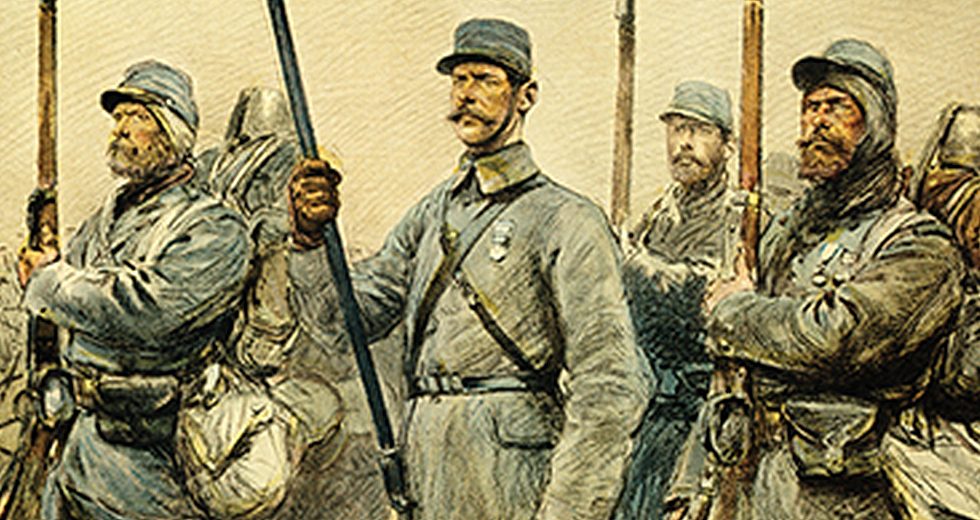
In the years leading up to the United States entering World War I, the Chicago Symphony Orchestra gave a number of premieres, featured prominent guest soloists, and made its first commercial recording. Additionally, Orchestra Hall hosted an extraordinary variety of events, several of which are illustrated below (all events in Orchestra Hall unless otherwise noted).

Albert Spalding (Moffett Chicago photo) and Arnold Schoenberg (Egon Schiele, Museum of Fine Arts, Boston)
On December 8, 1911, Albert Spalding is soloist with the Chicago Symphony Orchestra in the U.S. premiere of Sir Edward Elgar’s Violin Concerto. Frederick Stock conducts.
Albert Capellani’s film Les misérables (parts 1 and 2)—starring Henry Krauss as Jean Valjean and billed as “the greatest motion picture ever made”—is screened from August 21 through October 10, 1913.
Frederick Stock leads the Orchestra in the U.S. premiere of Arnold Schoenberg’s Five Pieces for Orchestra on October 31, 1913. (On February 8 and 9, 1934, the composer returns to Chicago to lead the work as guest conductor.)
On February 5, 1914, the North End Woman’s Club presents Anne Sullivan and Helen Keller in a demonstration of the technique used by Sullivan to teach Keller—blind and deaf since she was nineteen months old—how to speak.
William Henry Hackney presents a Colored Composers’ Concert featuring music by Samuel Coleridge-Taylor, Harry Burleigh, J. Rosamond Johnson, Will Marion Cook, and R. Nathaniel Dett on June 3, 1914. The Chicago Defender article (from June 6, 1914) describing the concert is here.
The Orchestra gives the U.S. premiere of Gigues from Claude Debussy’s Images for Orchestra on November 13, 1914. Frederick Stock conducts.

Apollo Club’s Messiah and Edith Lees with Havelock Ellis (Library of the London School of Economics and Political Science)
The Apollo Club of Chicago presents its annual performances of Handel’s Messiah at the Auditorium Theatre on December 27 and 28, 1914. Harrison M. Wild leads the Chicago Symphony Orchestra.
Edith Lees, author and the openly lesbian wife of Havelock Ellis, gives a lecture on February 4, 1915, advocating for the general acceptance of “deviants” (i.e. homosexuals). Offering Oscar Wilde and Michelangelo as examples of what the “abnormal” could accomplish, this is one of the earliest public calls for the acceptance of gay people.
On March 5, 1915, Frederick Stock leads the Orchestra in the U.S. premiere of Alexander Scriabin’s Prometheus.
Celebrating the opening of the Orchestra’s twenty-fifth season on October 15, 1915, Frederick Stock leads the world premiere of his Festival Prologue, which he had written while in California for the Panama–Pacific International Exposition. Stock considered the work “an expression of his esteem not only for that noble band of artists which for a quarter of a century has uplifted and upheld the musical culture of our city, but also for those who have permitted themselves to be thus uplifted and upheld—the music-loving people of Chicago.”
On February 4 and 5, 1916, Amy Beach is soloist in her Piano Concerto in C-sharp minor. Frederick Stock conducts.
Percy Grainger is soloist in the world premiere of John Alden Carpenter’s Concertino for Piano and Orchestra on March 10, 1916. Frederick Stock conducts.
On December 15, 1916, Frederick Stock leads the Orchestra in the world premiere of Thorwald Otterström’s American Negro Suite, incorporating melodies from Slave Songs of the United States—the first and most influential collection of African American music and spirituals, published in 1867.
Bengali poet and the first non-European recipient of the Nobel Prize for Literature, Sir Rabindranath Tagore reads from his own works on December 19, 1916.
On May 1, 1916, Frederick Stock and the Chicago Symphony Orchestra record for the first time (in an unidentified Chicago location): Mendelssohn’s Wedding March from A Midsummer Night’s Dream for the Columbia Graphophone Company.
Violinist Maud Powell and pianist Arthur Loesser (half-brother of Broadway composer Frank Loesser) appear in recital on February 18, 1917.
On March 25, 1917, Walter Damrosch leads the New York Symphony Orchestra in Beethoven’s Violin Concerto with Efrem Zimbalist and Brünnhilde’s Immolation from Wagner’s Götterdämmerung with Julia Claussen.
____________________________________________________
A Time for Reflection—A Message of Peace—a companion exhibit curated by the Rosenthal Archives of the Chicago Symphony Orchestra in collaboration with the Pritzker Military Museum & Library—will be on display in Symphony Center’s first-floor rotunda from October 2 through November 18, and the content also will be presented on CSO Sounds & Stories and the From the Archives blog.
This article also appears here. For event listings, please visit cso.org/armistice.
This exhibit is presented with the generous support of COL (IL) Jennifer N. Pritzker, IL ARNG (Retired), Founder and Chair, Pritzker Military Museum & Library, through the Pritzker Military Foundation.
Additional thanks to Shawn Sheehy and Jenna Harmon, along with the Arts Club of Chicago, Newberry Library, Poetry Foundation, and Ravinia Festival Association.
TOP: Heroes of the Marne 117th Infantry Regiment, Georges Scott. This poster shows French soldiers who fought in the First Battle of the Marne between September 6 and 12, 1914 (France, 1915). | Image: Pritzker Military Museum & Library





